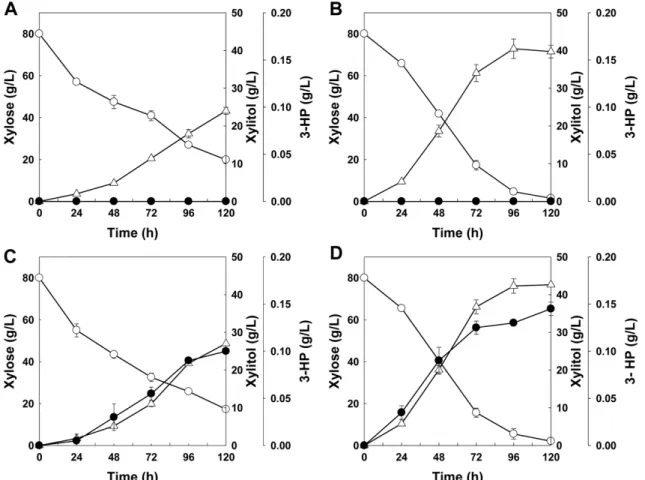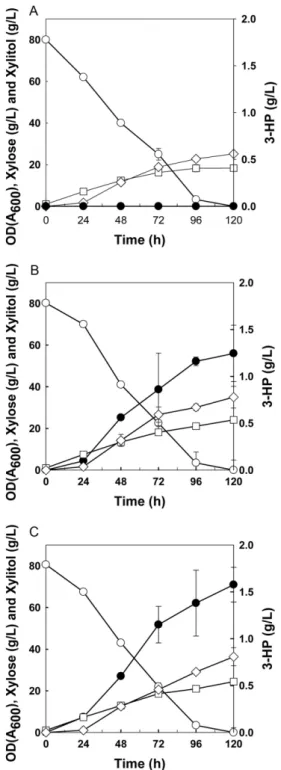Kluyveromyces marxianus 균주를 이용한 3-Hydroxypropionic acid 생산
박재범1†, 강경곤1,3†, 권덕호1,2,3, 하석진1,2,3*
Production of 3-Hydroxypropionic Acid by Engineered Kluyveromyces marxianus
Jae-Bum Park1†, Kyoung-Gon Kang1,3†, Deok-Ho Kwon1,2,3, and Suk-Jin Ha1,2,3*
Received: 19 October 2020 / Revised: 6 November 2020 / Accepted: 7 November 2020
© 2020 The Korean Society for Biotechnology and Bioengineering
Abstract: Thermotolerant yeast, Kluyveromyces marxianus was applied for the production of 3-hydroxypropionic acid (3- HP), which is mainly used as a raw material for biodegrad- able polymers. The MCR (malonyl-CoA reductase) gene orig- inated from the Chloroflexus aurantiacus strain was introduced into the engineered K. marxianus 17555-JBP2 strain showing improved xylose utilization in the previous study to develop the engineered K. marxianus JBP2_MCR strain. At 40
oC, K.
marxianus JBP2_MCR strain produced 0.14±0.00 g/L of 3-HP using xylose as a sole carbon source. As a result of measuring the enzymatic activity of malonyl-CoA reductase, the engi- neered K. marxianus JBP2_MCR strain exhibited 4.71 times higher MCR enzymatic activity than the parent strain. When 1.28 g/L malonyl-CoA was added into media, 1.58±0.18 g/L of 3-HP was produced by K. marxianus JBP2_MCR strain for 120 h.
Keywords: Kluyveromyces marxianus, 3-Hyroxypropionate, malonyl-CoA, malonyl-CoA reductase
1. INTRODUCTION
Kluyveromyces marxianus는 열 내성을 가진 것으로 알려진 효모 중 하나로, 일반적인 효모에 비해 비교적 높은 온도에 서도 생육이 가능하다는 장점을 지니고 있다 [1,2]. 열 내성 균주를 이용할 경우 높은 온도에서 생육이 가능하기 때문에 냉각에 소모되는 비용을 감소시킬 수 있으며 오염에 대한 위 험이 줄어들 수 있다는 장점이 있고 열 내성 균주의 특성을 활용하여 바이오매스를 이용한 유용물질 생산 시 SSF (simultaneous saccharification and fermentation)공정을 활용한 생산수율 및 생산성 증가도 기대할 수 있다 [3]. K. marxianus 는 자일로스를 대사할 수 있어 목질계 바이오매스를 이용할 경우 기존의 균주보다 다양한 기질의 효율적인 이용이 가능 하다는 장점을 지니고 있다 [4,5]. 하지만 K. marxianus는 연 구된 기간이 비교적 짧기 때문에 유전자 정보와 유전자 편집 도구가 미흡한 상황이나 이를 해결하기 위해 유전공학적 접 근을 통해 K. marxianus 균주를 개량하려는 시도들이 계속되 고 있다 [6,7].
3-Hydroxypropionic acid (3-HP)는 고부가가치를 지닌 다양 한 상업용 복합체들을 만들 수 있는 기초 물질 중 하나이다 [8]. 특히 poly(3-HP)와 같은 생분해성 고분자를 만드는데 주 로 이용되며, 이렇게 생산된 폴리에스터의 경우 기존의 석유 기반 물질보다 생분해성이 우수하며 재생이 가능하다는 장 점을 지니고 있어 3-HP생산과 관련된 연구들이 활발하게 진 행되고 있다 [9,10]. 3-HP의 생산은 주로 생물학적 방법을 이 용해 진행되며 주로 Klebsiella pneumonia, Escherichia coli, Saccharomyces cerevisiae 등의 균주가 이용된다 [11,12]. K.
pneumonia 균주를 이용한 3-HP 생산의 경우, Coenzyme- B
12(Co-B
12) 를 필요로 하는 글리세롤 탈수과정에 의해 진행 된다 [13]. 또 다른 경로로 malonyl-CoA를 기질로 이용할 수
†
These two authors contributed equally.
1
강원대학교 생물공학과
1
Department of Bioengineering and Technology, Kangwon National University, Chuncheon 24341, Korea
2
강원대학교 누룩연구소
2
Institute of Fermentation and Brewing, Kangwon National University, Chuncheon 24341, Korea
3
강원대학교 바이오헬스기기 융합기술 협동과정
3
Department of Biohealth-machinery convergence engineering, Kangwon National University, Chuncheon 24341, Korea
Tel.: +82-33-250-62778; Fax: +82-33-243-6350 E-mail: sjha@kangwon.ac.kr
Research Paper
재하는 중간물질로 malonyl-CoA를 이용한 3-HP 생합성 경 로의 경우 추가적인 기질을 필요로 하지 않는다는 장점을 지 니고 있다 [14].
선행 연구에서 mutant KmXYL1 유전자를 이용하여 재조합 K. marxianus 17555-JBP2 균주의 자일리톨 생산성을 증대시 키기 위한 연구를 수행하였다 [15,16]. 본 연구에서는 K.
marxianus JBP2 균주를 이용한 3-HP생산 가능성 확인을 위 해 Chloroflexus aurantiacus 균주로부터 유래한 malonyl- CoA reductase 유전자를 K. marxianus 17555-JBP2균주에 삽 입하여 자일로스를 이용한 3-HP생산량을 확인하였다.
2. MATERIALS AND METHODS
2.1. Malonyl-CoA reductase (MCR) 유전자의 과발현 Chloroflexus aurantiacus 균주로부터 유래한 malonyl-CoA reductase (MCR) 유전자를 K. marxianus 균주에 삽입하기 위 해 Integrated DNA Technologies, Inc. 의 홈페이지에서 제공 하는 Codon Optimization Tool을 이용하여 MCR 유전자의 코 돈 최적화를 진행한 후 마크로젠 (Seoul, Republic of Korea) 사에 의뢰하여 DNA합성을 진행했다. MCR 유전자를 확보 하기 위해 MCR_F_SpeI(5’-GGACTAGTATGAGCGGGAC AGGCA-3’), MCR_R_XhoI(5’-CCGCTCGAGTTATACGGTTA TGGCTCTACCACG-3’) primer를 이용하여 PCR을 통한 유 전자 증폭을 진행하였다. 이후 확보한 유전자들을 제한효소 를 이용하여 pJSKM316-GPD 벡터에 유전자를 삽입한 후 ScURA3_F(5’-TTCAATT CAATTCATCATTT-3’)와 CYC_R (5’-GGCCGCAAATTAAAGCCTTC-3’)primer를 이용하여 MCR 그리고 CYC-terminator유전자를 포함한 DNA cassette를 PCR을 통해 증폭하였다. K. marxianus 17555-JBP2 균주에 MCR 유전자를 포함한 DNA cassette를 삽입하기 위해 Ez- Yeast Transformation Kit (MP biochemicals, California, USA) 를 사용하였으며, 형질전환 이후 MCR 유전자를 포함한 DNA cassette가 삽입된 균주를 선별하기 위해 uracil이 결여 된 합성배지에 도말 한 후 30
oC 온도조건에서 3일간 배양하 여 선별하였다.
2.2. 효모 전배양 및 플라스크를 이용한 발효
효모의 전배양은 SC 배지 (Synthetic complete medium, Yeast nitrogen base without amino acids and with ammonium sulfate: 6.7 g/L) 를 사용하였으며 glucose 20 g/L를 첨가하여 사용하였다. 접종에 사용한 균주는 −80
oC에서 glycerol stock 방법으로 보관한 균주를 사용하였으며, SCD
20배지에 1% 농 도로 접종하여 200 rpm, 30
oC 조건으로 전배양을 진행하였 다. 전배양 후 대수기에 회수하여 멸균 증류수로 2회 세척하 여 본배양에 이용하였다. 3-HP 생산을 위한 발효실험을 위해 250 mL 삼각 플라스크에 자일로스 80 g/L가 첨가된 50 mL의 SCX
80배지를 사용하였다. 배양액의 pH를 유지하기 위해
속도와 30
oC 또는 40
oC 온도조건에서 발효를 진행하였다.
2.3. 효소활성측정
효소활성 측정에 사용된 효모들은 YPD
20배지에서 200 rpm, 30
oC 조건으로 배양한 후 멸균증류수로 2회 세척하고 50 mM PBS를 첨가하여 초음파 균질기 (Sonics & Materials INC., Newtown, CT, USA)로 효모를 파쇄하였다. 세포파쇄는 70%
amplitude 에서 pulse on 5초, pulse off 15초 조건으로 30분간 진행하였다. 효모 파쇄 후 4
oC, 10,000 x g 조건으로 5분간 원 심 분리 처리한 후 분리된 상등액을 이용하여 단백질 정량 및 효소 활성 측정을 진행했다. 단백질 정량은 bicinchoninic acid (BCA)을 이용하여 진행하였다. 기질로 사용되는 malonyl- CoA를 0.3 mM농도로, 그리고 조효소로 이용되는 NADPH 를 0.3 mM농도로 사용하여 반응을 진행하였으며, 30
oC와 340 nm파장에서 NADPH의 흡광도 감소량을 측정하여 감소 폭을 산출해 계산하였다.
2.4. 분석방법
효모의 성장은 600 nm 파장에서OD값을 UV-visible spectropho- tometer (Biomate 5, Thermo, NY)를 이용하여 측정했다. 배양 중 대사물질 (자일로스, 자일리톨, 에탄올) 분석은 high- performance liquid chromatography (HPLC 1200 Series, Agilent Technologies, Santa Clara, CA)에 Rezex ROA-Organic Acid H+ (8%) column (Phenomenex Inc., Torrance, CA)을 부착하 여 분석을 수행했다. 분석 조건은 HPLC에 부착되어있는 RID (refractive index detector) 를 이용했으며 용매는 0.005 N H
2SO
4를 사용했고 50
oC조건에서 분당 0.6 mL의 용매를 사용 하는 조건으로 분석을 진행했다. 배양액의 3-HP를 분석하기 위해 HPLC Chromaster (Hitachi, Japan)와 TSKgel G3000SWXL HPLC Column을 이용하여 분석을 수행하였으며, DAD (diode array detector) 를 이용하여 207 nm파장으로 분석하였다. 용 매로는 메탄올 (Sigma Aldrich, MO, USA) 5%, phosphoric acid 0.05%를 이용하였으며 30
oC조건에서 분당 0.8 mL의 용 매를 사용하는 조건으로 분석을 진행하였다.
3. RESULTS AND DISCUSSION
3.1. 재조합 K. marxianus JBP2_MCR균주의 3-HP 생합 성 확인
이전 연구에서 K. marxianus 17555-JBP2 균주는 자일로스로
부터 자일리톨 생산성을 증대 시키기 위해 개량된 균주이므
로 이와 같은 특성을 이용하여 자일로스로 부터 3-HP생산성
을 확인하는 연구를 수행하였다. K. marxianus 17555-JBP2
균주의 자일로스 소비 및 자일리톨 생산량이 배양 온도가 증
가함에 따라 증가한다는 것을 확인하였기 때문에 30
oC 와
40
oC 두 가지 온도 조건으로 배양을 수행하였으며, 배양을
위한 배지는 효모 배양에 사용되는 SC (synthetic complement)
배지에 자일로스를 80 g/L의 농도로 첨가하여 사용하였다.
배양온도를 30
oC로 조절하여 3-HP 생산성을 확인해본 결과 모균주인 K. marxianus 17555-JBP2는 배양 120시간에 61.00 ± 1.09 g/L의 자일로스를 소비하고 23.99 ± 0.88 g/L의 자일리 톨을 생합성하였으나 3-HP와 에탄올의 생합성은 확인되지 않았다. 반면에 재조합 균주인 K. marxianus JBP2_MCR 균 주는 자일로스 소비와 자일리톨 생합성은 거의 유사하였고 에탄올의 생합성 또한 없었으나 0.10 ± 0.00g/L의 3-HP를 생 산하였다 (Fig. 1). 배양 온도를 40
oC로 증가하여 3-HP생산성 을 확인한 결과 모균주의 자일로스 소비와 자일리톨 생합성 속도는 현저히 증가하였으나 여전히 3-HP를 전혀 생산하지 못한 반면 재조합 K. marxianus JBP2_MCR 균주는 유사한 수준의 자일로스 소비와 자일리톨 생합성을 확인하였으며 30
oC 와 마찬가지로 에탄올의 생합성은 없었으나 3-HP생산 량이 0.14 ± 0.00 g/L로 증진된 것을 확인할 수 있었다.
3.2. 모균주와 재조합 K. marxianus JBP2_MCR 균주의 MCR 효소활성 비교
재조합 K. marxianus JBP2_MCR 균주의 3-HP생산량이 0.14
± 0.00 g/L로 비교적 낮은 이유는 도입된 C. aurantiacus 균주 유래의 MCR 유전자가 효과적으로 발현이 되지 않았거나 효
소활성이 낮기 때문이라고 예측하였다. 따라서 이를 확인하 기 위해 C. aurantiacus 균주 유래의 MCR 유전자가 발현된 K. marxianus JBP2_MCR 균주와 모균주의 MCR 효소활성을 비교하였다. 효소 활성을 측정하기 위해 malonyl-CoA를 기 질로 사용했으며, 조효소로 첨가한 NADPH의 흡광도 감소 폭을 측정하여 효소의 활성을 간접적으로 확인하였다. 그 결 과 기질로 사용된 malonyl-CoA를 첨가하지 않은 음성 대조 군 (open symbol)의 경우 모균주와 재조합 K. marxianus JBP2_
MCR 균주 모두 흡광도가 소폭 감소하였으며 감소폭은 거의 유사하게 나타나는 것을 확인할 수 있었다 (Fig. 2). 반면에 malonyl-CoA 를 기질로 첨가하여 효소활성을 측정해본 결과 모균주의 효소활성에 비해 재조합 K. marxianus JBP2_MCR 균주의 효소활성이 더 높게 나타난 것을 확인할 수 있었다.
NADPH 의 감소량을 측정하고 cell extract의 단백질 농도를 측정한 결과, 모균주의 경우 1.26 ± 0.02 µmol/min·mg의 MCR 효소활성이 나타낸 반면, 재조합 K. marxianus JBP2_MCR 균주의 경우 약 4.71배 증가한 5.93 ± 0.02 µmol/min·mg의 MCR 효소활성을 나타내었다. 이러한 효소활성의 증가는 본 연구에서 삽입한 C. aurantiacus 균주 유래의 MCR 유전자가 재조합 K. marxianus JBP2_MCR 균주에서 효과적으로 발현 되어 효소활성을 갖기 때문이라고 사료된다.
Fig. 1. Comparisons of 3-HP production by the parental strain at 30
oC and 40
oC (A and B) and the engineered K. marxianus JBP2_MCR
strain at 30
oC and 40
oC (C and D). Symbols; xylose ( ○), xylitol (△), and 3-HP (●).
3.3. Malonyl-CoA를 기질로 이용한 경우 3-HP 생합성 증 가 확인
재조합 K. marxianus JBP2_MCR 균주에 도입된 C. aurantiacus 균주 유래의 MCR 유전자가 효과적으로 발현되어 효소활성 을 갖고 있음이 확인되었으므로 3-HP 생합성량의 농도가 낮 은 원인은 세포 내부의 malonyl-CoA 농도가 낮기 때문이라 고 예측하였다. 이러한 문제의 원인을 확인하기 위해 malonyl- CoA를 기질로 첨가하여 재조합 K. marxianus JBP2_MCR 균 주의 3-HP 생산량을 확인하였다. 이전과 동일한 SCX
80배지에 0 g/L (0 mmol/L), 0.85 g/L (1.0 mmol/L), 1.28 g/L (1.5 mmol/L) 의 농도로 malonyl-CoA를 첨가하여 배양을 수행하였다 (Fig.
3). Malonyl-CoA를 0.85 g/L 농도의 첨가한 경우 배양 120시 간에 1.24 ± 0.3 g/L의 3-HP를 생산하였으며, 1.28 g/L 농도의 malonyl-CoA를 첨가해준 경우엔 1.58 ± 0.18 g/L의 3-HP를 생산하였다. 배양결과 malonyl-CoA를 기질로 첨가한 경우 3-HP의 생합성 농도가 크게 증가하는 것을 확인 할 수 있었 다. 따라서 재조합 K. marxianus JBP2_MCR 균주에 삽입한 C. aurantiacus 균주 유래의 MCR 유전자는 효과적으로 발현 되어 효소활성을 갖는 것으로 사료되지만 다만 3-HP의 전구 물질인 malonyl-CoA의 세포 내부 농도가 낮아 3-HP의 생합 성 농도가 낮게 생산된 것이라 판단하였다. 따라서 이를 해 결하기 위해서는 malonyl-CoA의 생합성을 증가시키기 위한 발효조건을 탐색하거나 또는 acetyl-CoA로부터 malonyl- CoA를 생합성하는데 관여하는 acetyl-CoA carboxylase (ACC) 를 추가로 도입하는 연구가 필요할 것으로 사료된다.
4. CONCLUSION
내열성 효모인 K. marxianus를 이용하여 생분해성 고분자의
원료로서 주로 이용되는 3-HP를 생합성하기 위한 연구를 수 행하였다. 이전 연구에서 개발된 자일로스의 이용이 증가된 재조합 K. marxianus 17555-JBP2 균주에 C. aurantiacus 균주 유래의 MCR 유전자를 도입하여 재조합 K. marxianus JBP2_
MCR 균주를 개발하였다. 자일로스를 기질로 하여 40
oC 온 Fig. 2. Enzymatic assay of malonyl-CoA reductase (MCR) by the
parental strain (square) and the engineered K. marxianus JBP2_
MCR strain (circle) with (closed) or without (open) malonyl-CoA as a substrate.
Fig. 3. Enhanced 3-HP production by the engineered K.
marxianus JBP2_MCR strain with addition of malonyl-CoA as a
substrate. 0.0 mmol (A), 1.0 mmol/L (B), or 1.5 mmol/L (C) of malonyl-
CoA was added. Symbols; xylose (○), xylitol (◇), 3-HP (●), and
OD(A6
00) (□).
도조건에서 K. marxianus JBP2_MCR 균주는 0.14 ± 0.00 g/L 의 3-HP를 생산하는 것이 확인되었다. 비교적 낮은 3-HP 생 합성의 원인을 찾기 위해 MCR의 효소 활성을 측정한 결과, 재조합 K. marxianus JBP2_MCR 균주가 모균주에 비해 4.71 배의 높은 MCR 효소활성을 갖는 것을 확인하였다. 따라서 K. marxianus JBP2_MCR 균주의 낮은 3-HP 생합성의 원인 은 세포 내부의 낮은 malonyl-CoA 농도라고 판단되어 기질 로 1.28 g/L의 malonyl-CoA를 추가한 결과 배양 120시간에 1.58 ± 0.18 g/L 의 3-HP를 생산할 수 있었다.
Acknowledgements
본 연구는 2019년도 한국연구재단 이공분야기초연구사업 (NRF-2019R1F1A1055315)의 지원을 받아 수행됨. 그리고 본 연구는 2020년 대학혁신지원사업 도전 연구비지원 프로 그램의 지원을 받아 수행됨.
REFERENCES

